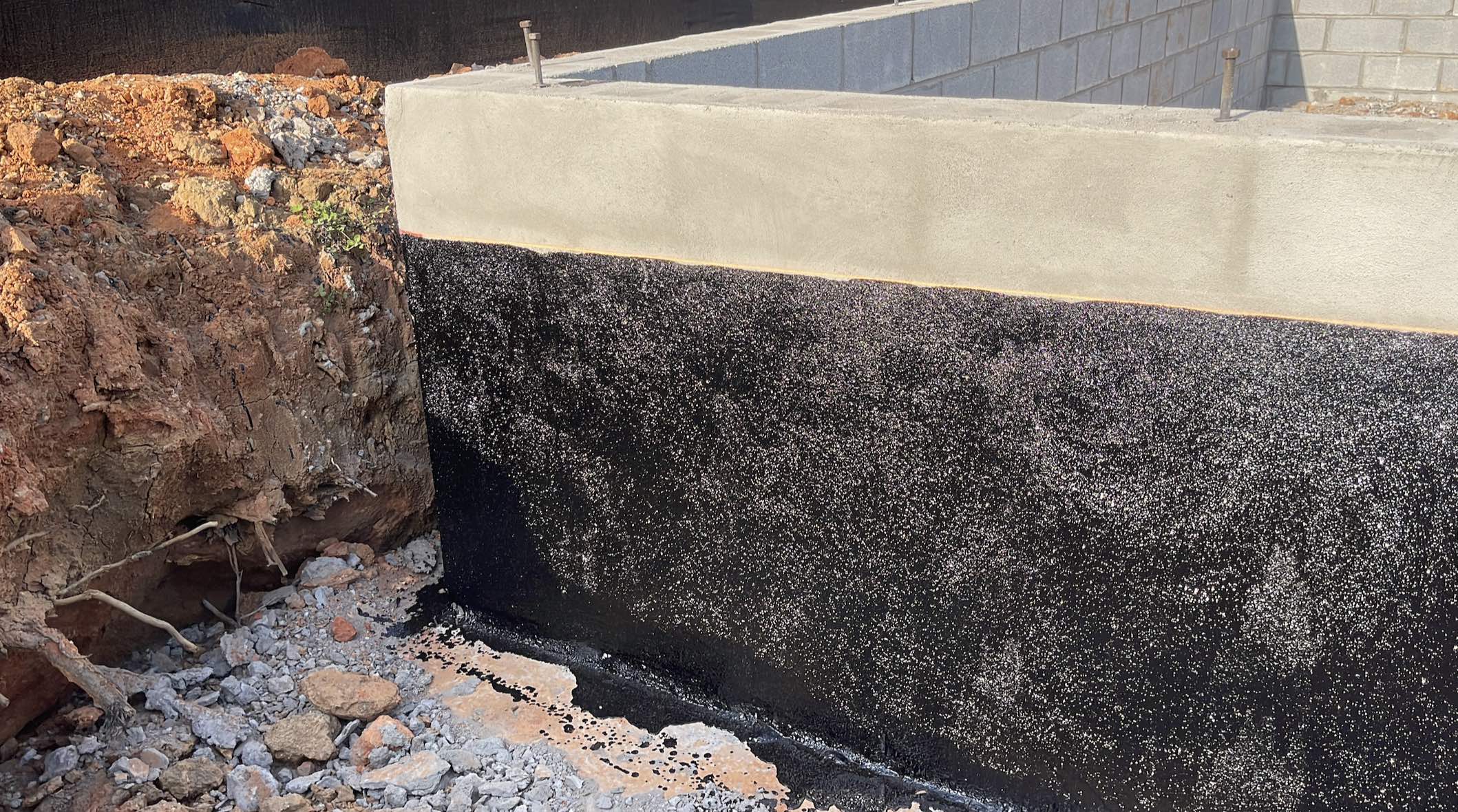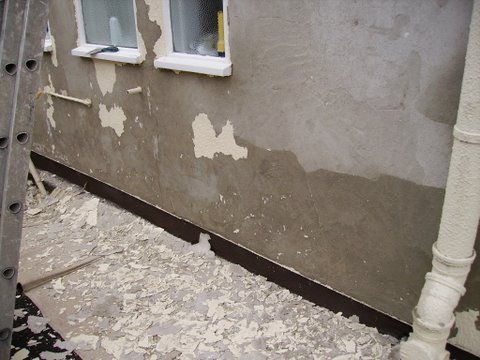Comprehending the Significance of Damp Proofing in Stopping Structural Damages
Wet proofing functions as a necessary defense against moisture seepage in structures. This protective action can avoid substantial structural damage, yet many building proprietors continue to be not aware of its relevance. Acknowledging the indications of dampness and understanding the numerous services offered can be vital. Overlooking damp proofing can lead to severe effects. What are the details risks and solutions that homeowner should consider?
What Perspires Proofing and How Does It Function?
Wet proofing works as an essential obstacle against dampness intrusion in structures. mould removal newcastle. This procedure includes using particular materials and strategies to stop water from permeating wall surfaces, floors, and various other structural aspects. Typically, damp proofing can be achieved through the installment of moist proof membrane layers, coatings, or the use of specialized sealants.These methods function by developing a protective layer that prevents dampness movement, guaranteeing that the interior atmosphere stays healthy and balanced and dry. Wet proofing is especially vital in areas prone to high humidity or groundwater, as it helps keep the stability of the framework over time.Moreover, effective damp proofing adds to energy performance by avoiding warmth loss associated with wet environments. By resolving potential wetness problems prior to they intensify, damp proofing functions as a positive measure in safeguarding buildings from the destructive impacts of water damages, ultimately extending their life-span and keeping their value
Common Indicators of Wetness in a Structure
Moisture issues within a building can show up through several noticeable indicators that show the visibility of dampness. One prominent indicator is the appearance of water spots on walls or ceilings, which often shows moisture seepage. In addition, peeling off or gurgling paint can suggest that excess moisture is trapped beneath the surface area, leading to deterioration. One more common indicator is the existence of mold and mildew and mold, which prosper in wet problems and can typically be recognized by their mildewy odor. Moreover, a surge in moisture degrees can trigger condensation on home windows and various other surfaces, highlighting wetness troubles. Irregular or deformed flooring might signify underlying moisture that jeopardizes structural honesty. Acknowledging these indications early can assist minimize prospective damage and keep a safe living atmosphere. Routine evaluations and prompt action are crucial in addressing dampness concerns prior to they escalate.
The Risks of Ignoring Damp Proofing
Ignoring damp proofing can cause substantial risks to a structure's architectural integrity, as wetness accumulation might weaken foundations and walls. In addition, long term wetness develops a setting for mold and mildew development, posturing significant wellness threats to owners. Addressing these dangers is crucial for making certain both safety and long life of the residential or commercial property.
Structural Stability Hazards
When house owners forget the relevance of reliable wet proofing, they subject their homes to significant architectural honesty threats. Prolonged moisture seepage can result in the advancement of mold, which deteriorates foundational elements and can endanger total stability. In addition, excess dampness can erode concrete and brickwork, resulting in splits and architectural failings. Wood components are especially prone; they can rot and shed load-bearing capacity, posturing significant risks to the building's structure. Untreated wet problems might draw in pests, such as termites, which additionally worsen structural deterioration. Eventually, disregarding wet proofing steps can cause costly repairs and possible safety hazards, emphasizing the necessary role of proactive damp monitoring in protecting the stability of homes.
Carcinogen Issues
Just how can a relatively small oversight result in severe wellness dangers? Disregarding damp proofing can develop an environment favorable to mold growth, which positions significant wellness dangers. Mold spores can trigger allergies, respiratory problems, and other health difficulties, especially in vulnerable populations such as kids, the senior, and individuals with pre-existing conditions. Furthermore, consistent dampness can draw in insects like rats and pests, which carry conditions that even more compromise wellness. The visibility of wetness likewise adds to a decline in interior air high quality, intensifying bronchial asthma and various other respiratory ailments. The failure to address moist issues not just threatens structural integrity however additionally endangers the health of passengers, highlighting the vital demand for effective wet proofing procedures.
Various Sorts Of Damp Proofing Solutions
Although different factors can contribute to damp problems in structures, picking the proper wet proofing remedy is important for maintaining structural integrity. Several alternatives are available, each customized to details conditions.One typical service is a damp-proof membrane layer (DPM), normally made from polyethylene or asphalt, which is mounted in wall surfaces and floorings to stop wetness access. An additional choice is damp-proof courses (DPC), which are layers of waterproof material put within wall surfaces to block rising damp.Chemical damp proofing entails injecting waterproofing chemicals into walls to develop an obstacle against dampness. In addition, external therapies such as tanking, which includes using a waterproof layer to the beyond structures, can be efficient in protecting against water penetration.Each service has its advantages and is picked based upon the building's particular issues, environmental problems, and lasting upkeep factors to consider, making certain optimal defense here versus damp-related damages.

The Price of Damp Damage vs. Avoidance
Recognizing the financial effects of wet damage contrasted to prevention highlights the importance of aggressive procedures. The costs linked with damp damage can be considerable, including repair work to structural elements, mold removal, and potential health-related expenses. Homeowners might deal with substantial economic pressure if extensive damages occurs, leading to raised insurance premiums and lost home value.In comparison, purchasing moist proofing services is commonly much more cost-effective. First costs for prevention approaches, such as boosting or mounting damp-proof membrane layers drainage systems, are usually outweighed by the long-term cost savings from preventing pricey repair services. In addition, avoiding moist problems can enhance a home's overall value and charm, making it a sensible financial investment. When reviewing the cost of damp damage versus avoidance, it ends up being clear that taking aggressive actions can guard financial passions and keep the honesty of the building over time.
Picking the Right Damp Proofing Method for Your Home
Which moist proofing technique is most suitable for a details property often relies on numerous factors, consisting of the building's age, existing dampness problems, and regional ecological conditions. For older frameworks, traditional methods such as bitumen membranes or cementitious coverings might be much more effective, as they can give a robust barrier against climbing moist. In comparison, more recent structures may benefit from modern options like injected damp-proof training courses, which are less intrusive and can be customized to certain moisture challenges.Additionally, residential or commercial properties in areas with high water tables or hefty rainfall might need advanced techniques, such as dental caries wall surface drain systems or external waterproofing. Home owners ought to likewise take into consideration the specific materials utilized in their building's building and construction, as some methods may not work. Inevitably, a detailed assessment by an expert can guide homeowner in choosing one of the most efficient damp proofing technique customized to their one-of-a-kind circumstances.
Keeping Your Damp Proofing System In Time
Routine upkeep of a wet proofing system is crucial for ensuring its long-lasting efficiency and shielding a property from moisture-related damages. Homeowner should carry out routine assessments to identify any type of indications of wear or concession in the damp proofing layer. This consists of checking for cracks, peeling paint, or mold growth, which may show wetness intrusion.Additionally, it is a good idea to tidy seamless gutters and downspouts frequently to avoid water accumulation around the foundation. Reapplying sealers or membrane layers might be necessary if degeneration is observed.Engaging expert services for periodic evaluations can better boost the resilience of the system. These specialists can provide insights right into possible vulnerabilities and advise prompt repair services.
Often Asked Questions
For How Long Does Damp Proofing Treatment Last Prior To Needing Repair Work?
The durability of moist proofing therapy usually ranges from 10 to three decades, depending upon variables such as the method used, environmental conditions, and upkeep methods. Regular examinations can aid identify when repair work might be needed.
Is DIY Damp Proofing Effective Compared to Specialist Services?
The effectiveness of do it yourself moist proofing differs significantly. damp proofing newcastle. While some individuals may achieve sufficient outcomes, expert solutions usually assure extensive solutions, leveraging expertise and high quality products to avoid future concerns more accurately than many do it yourself efforts
Can Damp Proofing Improve Indoor Air Quality?
The concern of whether moist proofing can improve interior air top quality develops regularly. Effective damp proofing decreases dampness levels, thus lessening mold and mildew growth and allergens, inevitably contributing to a healthier indoor setting for passengers.
Are There Specific Regulations for Damp Proofing in Various Areas?
Rules for wet proofing differ by area, commonly affected by neighborhood structure codes and environmental conditions. Compliance guarantees effective wetness control, safeguarding frameworks and promoting safety, which highlights the necessity for adherence to these certain policies.

What Are the Long-Term Advantages of Proper Damp Proofing?
The long-term advantages of appropriate moist proofing consist of boosted structural integrity, minimized maintenance costs, improved interior air high quality, and boosted home value. These benefits contribute to a healthier living atmosphere and prolonged life expectancy of structures. Generally, moist proofing can be attained with the installment of damp evidence membranes, coatings, or the usage of specialized sealants.These techniques function by producing a protective layer that hinders dampness movement, making sure that the indoor setting continues to be healthy and completely dry. Wet proofing is specifically vital in areas susceptible to high moisture or groundwater, as it assists maintain the integrity of the structure over time.Moreover, effective moist proofing contributes to power performance by avoiding warm loss linked with moist environments. Overlooking wet proofing can lead to significant dangers to a building's structural integrity, as wetness buildup may damage wall surfaces and foundations (mould treatment newcastle). Numerous elements can add to damp issues in buildings, choosing the suitable damp proofing option is important for protecting architectural integrity. Which damp proofing technique is most appropriate for a specific property frequently depends on different elements, consisting of the building's age, existing moisture concerns, and local ecological problems